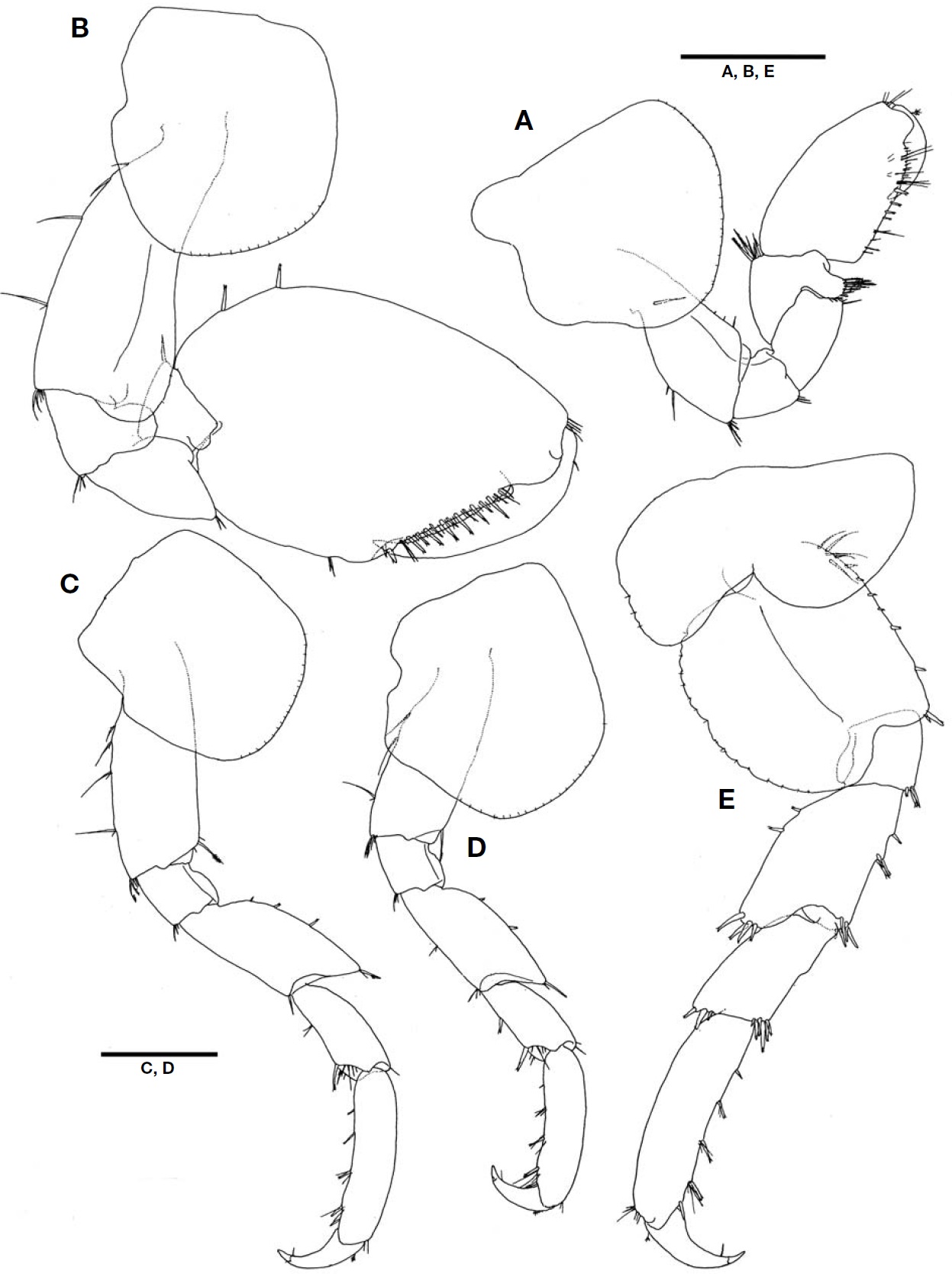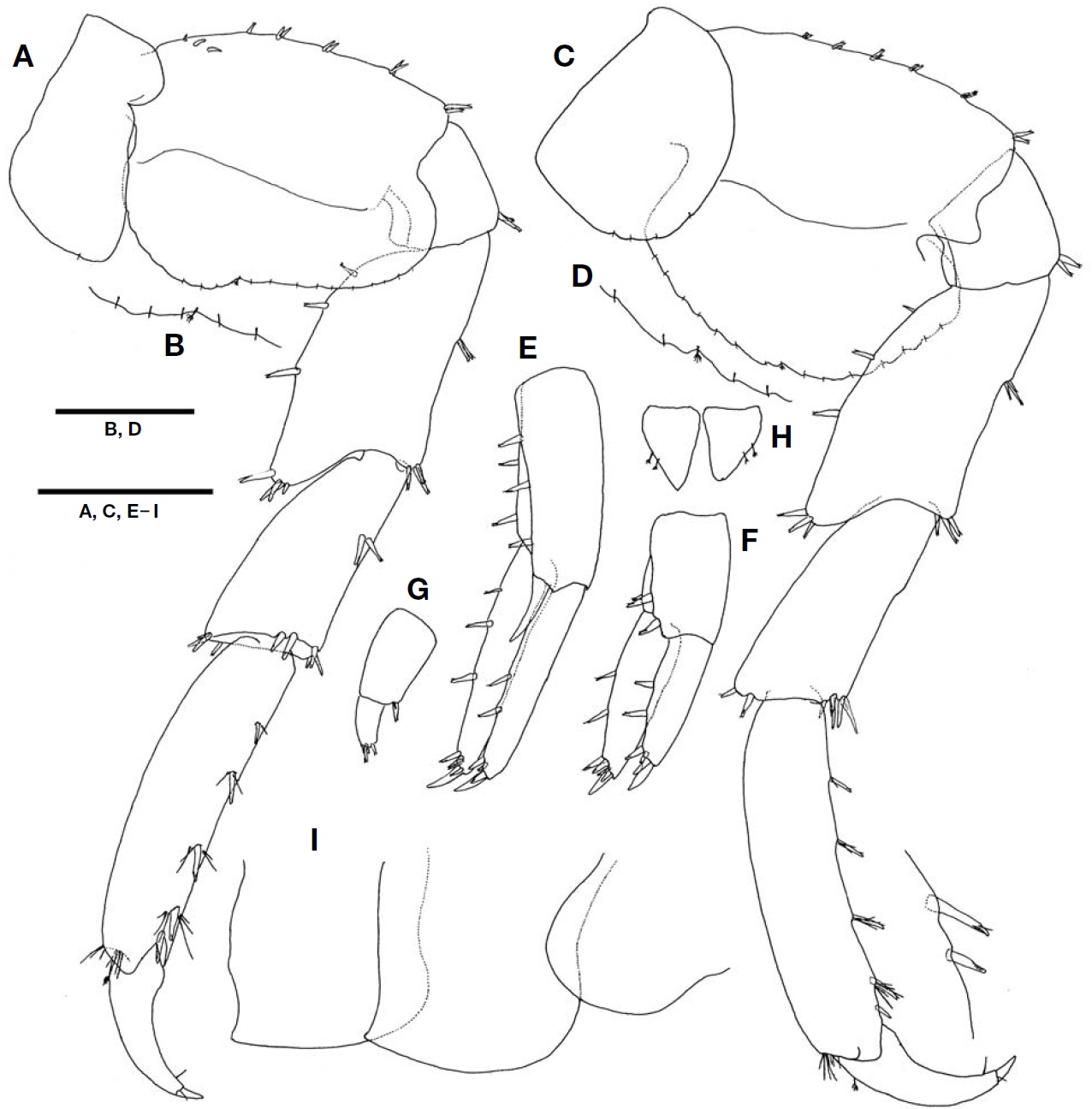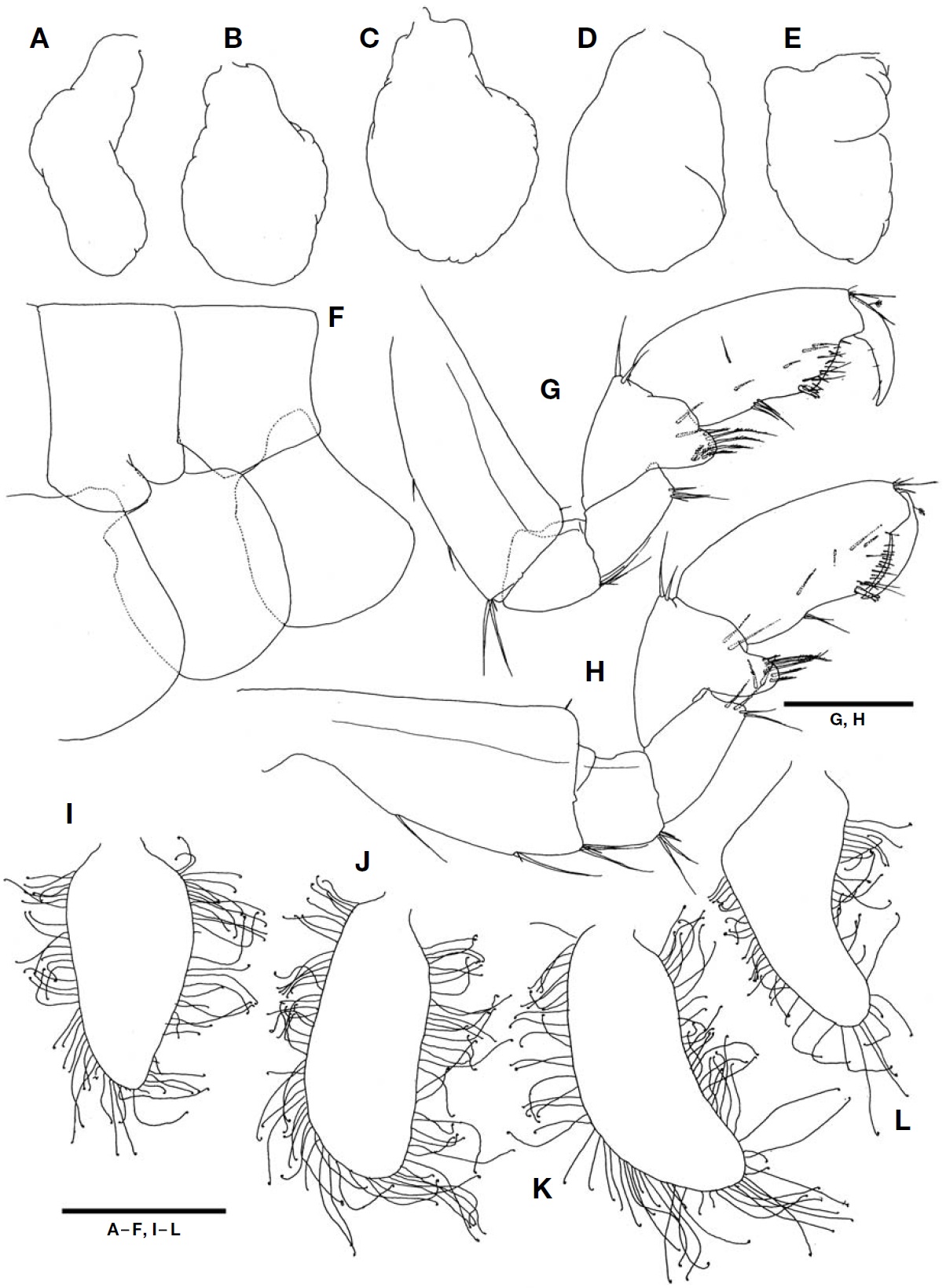



The species of Hyalidae Bulycheva, 1957 (Crustacea: Amphipoda) are usually predominant species among macroalgae or mussels inhabiting the intertidal zone and shallow waters of tropical and subtropical regions (Hiwatari and Kajihara, 1981; Hiwatari, 2003; Serejo and Sittrop, 2009), and these small herbivorous species may play important ecological roles in structuring intertidal assemblage (Schreider et al., 2003).
Bousfield and Hendrycks (2002) revised the Hyalidae species of the North Pacific Basin based on five characters: hydrodynamic lobes of the gnathopods (anterior lobes of basis and ischium), surge seta and notch of basis on pereopods 5-7, preamplexing notch of female, posterior marginal cusps of coxae 1-4, and forms of oostegites and marginal setae. As a result, large
Hiwatari (2003) reviewed the genus
Samples were collected by washing of algae using sieve in the littoral intertidal zone. Specimens were fixed initially with 5% formaldehyde-seawater solution, and preserved with 85% ethyl alcohol after sorting in the laboratory. The appendages of specimens were dissected in a petri dish filled with glycerol, using dissection pincer and needle, under the stereomicroscope (SZH10; Olympus, Tokyo, Japan), and mounted on temporary or permanent slide. Drawings and measurements were performed by light microscope (LABOPHOT-2; Nikon, Tokyo, Japan) with the aid of a drawing tube.
Order Amphipoda Latreille, 1816
Suborder Gammaridea Latreille, 1803
Family Hyalidae Bulycheva, 1957
Subfamily Hyalinae Barnard, 1972
Genus Protohyale Bousfield and Hendrycks, 2002
Subgenus Boreohyale Bousfield and Hendrycks, 2002
Key to the species of the genus
1. Propodus of ganthopod 1 with largely produced posterior cusp in matured male ???????????????????????????????????????????????????? ??????????????????P. (B.) pumila (Hiwatari and Kajihara, 1981)
- Propodus of ganthopod 1 without largely produced posterior cusp in matured male ?????????????????????????????????????????????? ????????????????????????????????P. (B.) triangulata (Hiwatari, 2003)
1*
Material examined. Korea: 17♂♂ 21♀♀, Jeollanam-do: Wando-gun, Soan-myeon, Bija-ri, 12 May 2010, Jung TW; 1♂ 1♀, Wando-gun, Chungsan-myeon, Sinheung-ri, 9 Jun 2010, Jung TW; 2♂♂ 2♀♀, Chungcheongnam-do: Seocheon- gun, Seo-myeon, Chunjangdae beach, Dodun-ri, 24 Sep 2009, Kim JG.
Description. Male: Body medium, stout, about 10.2 mm long.
Head (Fig. 1A), rostrum short, minute; anterior cephalic lobe obliquely truncated, apex slightly concave; eyes circular, medium in size. Posterodistal margin of pleonal epimera 1 rounded, and epimera 2-3 subacute (Fig. 3I).
Antenna 1 (Fig. 1A) about half of antenna 2, tip of flagellum over the peduncle 5 of antenna 2; length ratio of peduncle 1-3 1 : 0.70 : 0.58, article 1 with a pair of penicillate setae anteromedially; flagellum short, composed of more than 12 segments, each segment with 1 or 2 aesthetascs, but distal 2 segments not bearing.
Antenna 2 (Fig. 1A) not reaching half of body length; gland cone produced, with a spine apically; peduncle 3, distal margin truncated obliquely; peduncle 5 subequal to peduncle 3 and 4 combined in length; flagellum long, composed of 28 segments.
Upper lip (Fig. 1C). Apical margin rounded with short bristles.
Lower lip (Fig. 1B) ordinary, inner lobe indistinct; outer lobe, apical margin rounded, with short bristles; mandibular processes developed.
Left mandible (Fig. 1D). Incisor 7-toothed; lacinia mobilis 5-toothed; 3 pectinate accessory blades; molar process well developed with one plumose seta.
Right mandible (Fig. 1E, F). Incisor 6 and 1/2-toothed; lacinia mobilis tricuspate consisting of 2 pectinate and 1 blunt teeth; 2 pectinate accessory blades; molar well developed with one plumose seta.
Maxilla 1 (Fig. 1H). Inner plate gradually slendered distally, with 2 plumose apical setae; outer plate with 9 toothed spines distally; palp 1-articulate, with 2 different apical setae in length.
Maxilla 2 (Fig. 1G). Inner plate, apical margin obliquely rounded, with two row composed of pectinate and simple setae, respectively, inner distal corner with a long pectinate seta; outer plate, apical setae longer than that of inner plate.
Maxilliped (Fig. 1I). Inner plate with 3 stout apical spines and several plumose setae near the inner and apical margins; outer plate, apical margin rounded, spatulate, reaching middle of segment 2 of palp, with a row of several plumose setae apically; palp composed of 4 segments, distal margin of segment 1 oblique, inner margin of segment 2 and 3 slightly sinuate with numerous setae, segment 3 with 2 rows composed of several pectinate setae near the distal margin, segment 4 falcate, surface and inner margin pectinate, inner margin with several short and long setae beyond the tip of apical spine, apical spine elongate.
Gnathopod 1 (Fig. 2A). Coxa broad, slightly extended forward, posterior cusp lacking; basis trapezoidal, posterior margin with 2 medial setae; ischium, anterior lobe weak; merus subrectangular, slightly extended posterodistally; carpus, anterior margin rounded, with 5 pectinate setae, carpal lobe developed but lacking serration, with a row composed of several pectinate setae; propodus triangular in shape, posteroproximal corner subquadrate, palm and posterior margin not clear, but bearing a defining spine, palmer margin lined with fine and normal setae; dactylus falcate.
Gnathopod 2 (Fig. 2B). Coxa subquadrate, anterior and ventral margin convex, posterior cusp weak; basis broadly
lobate anterodistally, posterior margin with 4 setae; ischium with a hemicircular anterior lobe; merus, posterodistal corner produced distally; carpus with a small hemicircular lobe ventrally, and anterodistal corner with a stout spine; propodus large, subovate, anterior margin convex, with 2 spines, palm defined by inner and outer spines, slightly shorter than posterior margin, lined with stout spines and short setae at inner and outer margin, proximal margin of palm with a weak hump; dactylus fitting palm.
Pereopod 3 (Fig. 2C). Coxa subquadrate, ventral margin convex; basis slendered, slightly trapezoidal, anterior lobe weak, with a plumose seta distally, posterior margin with 4 pairs of a short and a long seta, and 4 pectinate distal setae; ischium, anterior lobe weak; merus, anterior margin expanded anteriorly, with 3 spines and produced distally, anterodistal corner with a pectinate and a simple seta; carpus shorter than merus, slightly extended distally, with a stout spine at posterodistal corner; propodus slender, anterior margin unarmed, posterior margin with 4 spines and a distal locking spine; dactylus curved.
Pereopod 4 (Fig. 2D) similar in size and shape with pereopod 3 except for larger coxa with bisinuate posterodoral excavation.
Pereopod 5 (Fig. 2E). Coxa bilobate, posterior lobe slightly dilated posterodistally; basis, anterior margin with 5 long setae proximally and lined with several single spines, distal corner with a large and a small spine, posterior margin broadly expanded, subcircular, weakly crenulated, lined with minute setae, with a notch medially bearing a penicillate seta; ischium subquadrate, with a weak posterior lobe; merus, anterior margin with 1 and 3 medial spines in turn, distal corner with 5 spines, posterior margin expanded posterodistally, with 2 medial spines, posterodistal corner with 4 stout spines; carpus gradually extending distally, each antero- and posterodistal corner with a group composed of 6 and 3 spines, respectively; propodus slender, anterior margin with 4 spines and a distal locking spine, posterior margin unarmed; dactylus falcate.
Pereopod 6 (Fig. 3A, B) larger than pereopod 5; coxa bilobate, anterior lobe small; basis, anterior margin slightly convex, with 3 small spines proximally, and lined with 1 and 3 pairs of small spines, distal corner with a pair of spines, posterior margin broadly expanded, but not subcircular, slightly flattened, lined with minute setae, 1/3 proximal margin with a notch bearing a penicillate seta; ischium subquadrate, with a posterior lobe; merus, posterior margin drastically expanded posterodistally, with 3 spines, distal corner produced distally with a group of 4 spines, anterior margin with a pair of medial spines, distal corner with a group of 3 spines; carpus gradually extending posterodistally, anteromedial margin with a pair of spines, each antero- and posterodistal corner with a group of 5 and 4 spines, respectively; propodus, anterior margin with 4 spines and a distal locking spine, posterior margin unarmed; dactylus falcate.
Pereopod 7 (Fig. 3C, D). Coxa unilobate, ventral margin rounded, posteroventral corner weakly crenulated, with minute setae; basis, anterior margin slightly convex, lined with 5 pairs of small spines, distal corner with a pair of spines, posterior margin broadly expanded, slightly dilated posterodistally, weakly crenulated, lined with minute setae, with a medial notch that bearing a penicillate seta; other segments similar to that of pereopod 6 in shape.
Uropod 1 (Fig. 3E). Peduncle with a large distolateral spine and 2 inner and 3 outer dorsolateral spines; inner and outer rami subequal in length, inner ramus with 3 dorsolateral spine, 2 pairs of apicomost spines and a stout apical spine, outer ramus with 2 dorsolateral spines, 3 apicomost spines and a stout apical spine.
Uropod 2 (Fig. 3F). Peduncle stout but short, 1 inner and 2 outer lateral spines; inner ramus longer than outer ramus, with 2 dorsal spines, a pairs of apicomost spines, and a stout apical spine, outer rami with 2 dorsolateral spines, 3 apicomost spines and a stout apical spine.
Uropod 3 (Fig. 3G) uniramus; peduncle twice length of ramus, with 2 apicodorsal spines; ramus with 4 apical spines.
Telson (Fig. 3H) cleft completely; each lobe subtriangular.
Female: Gnathopod 1 (Fig. 4G). Basis slightly trapezoidal in form, anterior lobe present but not developed, with a minute seta at distal corner; ischum subquadrate, anterior lobe weak; posterodistal margin of merus slightly pointed; carpus lobe shallow, lacking serration, lined with 7 pectinate setae; propodus slender, subrectangular, middle of posterior margin slightly concave with 3 setae, palm oblique, defined by 2 spines; dactylus fitting palm.
Gnathopod 2 (Fig. 4H) similar to gnathopod 1 but larger.
Oostegite of gnathopod 2 subtriangular; oostegites of pereopod 3 and 4 elongate oval, and that of pereopod 5 roundish triangular in shape (Fig. 4I-L).
Distribution. Korea, Japan.
Remarks. Bousfield and Hendrycks (2002) suggested that the preamplexing notch of pereon segment 2 of matured females is generic or subgeneric, and constituted specific character states of reproductive morphology in the family Hyalidae. According to them, a newly recorded Korean species,
materials regarded as
margin of the peduncle of uropod 3 and the lateral margin of telson. These seem to be variations, but the real meanings of them are in need of further study.
Korean name: 1*??????????????????



